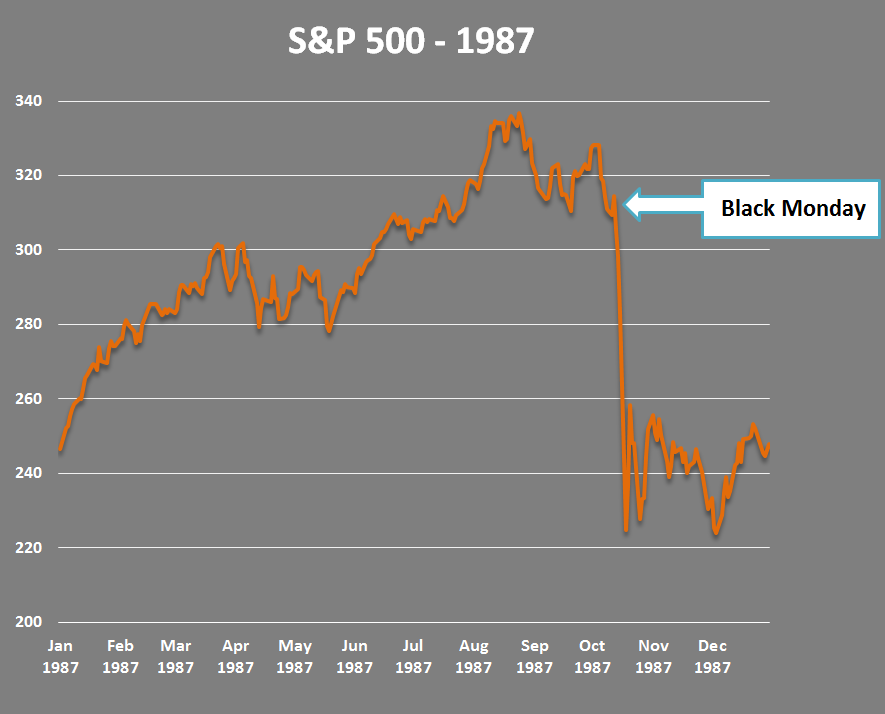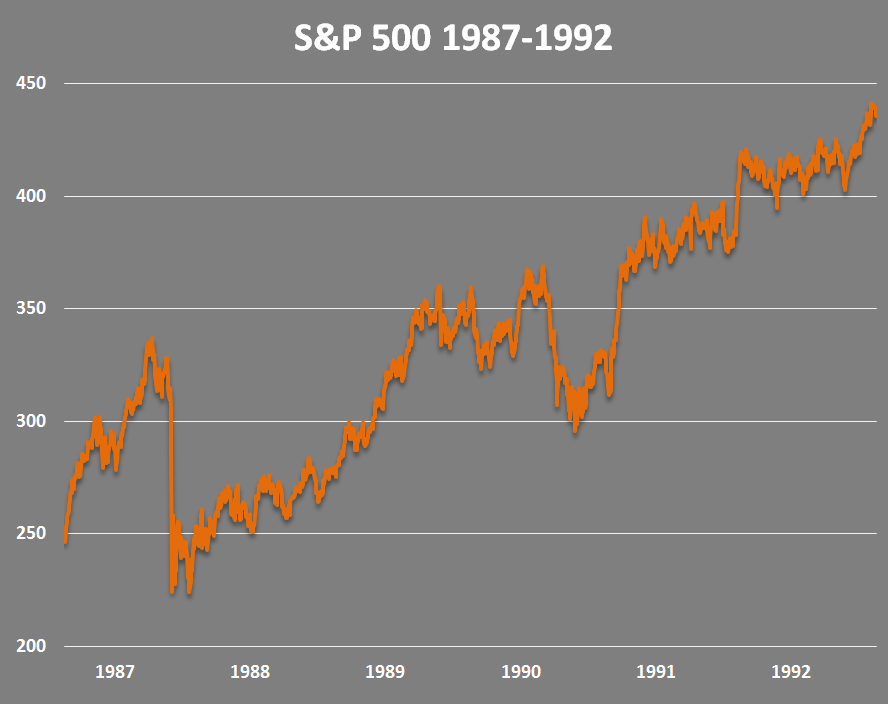If you’re in the business of fear-mongering, one of the go-to moves to try to scare  investors is to predict that the markets are looking eerily similar to October of 1987. That being said, you could actually argue that the 1987 crash was a good thing for the markets. It knocked some of the wind out of its sails after more than doubling from 1982-1986 so it begs the question “Would a Repeat of the 1987 Crash Really Be That Bad?”.
investors is to predict that the markets are looking eerily similar to October of 1987. That being said, you could actually argue that the 1987 crash was a good thing for the markets. It knocked some of the wind out of its sails after more than doubling from 1982-1986 so it begs the question “Would a Repeat of the 1987 Crash Really Be That Bad?”.
The above introductory comments are edited excerpts from an article* by Ben Carlson (awealthofcommonsense.com) entitled Would a Repeat of the 1987 Crash Really Be That Bad?.
Carlson goes on to say in further edited excerpts:
Black Monday is forever seared into the psyche of every trader and investor that was part of the markets on that fateful day. Investors of today are constantly reminded about the time the S&P 500 dropped more than 20% in a single day.
What many people don’t realize is that the three days leading up to Black Monday saw stocks fall over 10%, including a 5% drop on the preceding Friday. So in four days stocks were down more than 30%.
Interestingly enough, on a price basis the S&P finished the year basically flat, but on a total return basis, with dividends, was up around 5%. Doesn’t matter — crash, crash, crash is all anyone remembers.
It’s also worth noting that Black Monday didn’t even really derail the market. Here’s the S&P over a six year period from 1987 through 1992:
Now 1987 looks a little more manageable. Still a huge drop, but in the context of a market that was up over 120% or 14% a year from the start of 1987 through the end of 1992, not too bad. No one talks as much about the gains, but investors will always speak of the huge Black Monday crash. This is a classic case of short-term myopic loss aversion overwhelming long-term market gains.
You could actually argue that the 1987 crash was a good thing for the markets. It knocked some of the wind out of its sails after more than doubling from 1982-1986.
From current levels, a 30% drop in the S&P 500 would take the index down to just over 1,400. That’s a mark last seen in December of 2012. So all of 2013 and 2014’s gains would be wiped out.
The S&P 500 currently trades at a P/E multiple of roughly 17x this year’s earnings. Earnings have actually grown more than 16% since late 2012 so a 30% drop would leave us with a P/E ratio of 12x. For anyone with a decent slug of human capital in the form of future savings, this type of swift wipeout would be a gift. Stocks would be marked down at a huge discount to current valuations.
This type of loss would [be] tough for those with a mature portfolio, but for everyone else the biggest issue would be psychological. Stock market crashes are always thought of in terms of being frightening, scary and unnerving…[but] market crashes [should be seen] as good news. Changing your mindset from how a crash affects your current performance to how it will affect your future performance is one of the keys to mastering your emotions when investing.
Conclusion
Historical market scenarios never happen exactly like they did in the past, so this is really just an exercise in crash preparation for the next time the market takes a dive. These periods will never be easy, but they are necessary and one of the best things that can happen to an investor with a long time horizon, provided you have the right mindset.
Editor’s Note: The author’s views and conclusions in the above article are unaltered and no personal comments have been included to maintain the integrity of the original post. Furthermore, the views, conclusions and any recommendations offered in this article are not to be construed as an endorsement of such by the editor.
*http://awealthofcommonsense.com/repeat-1987-crash-really-bad/
If you liked this article then “Follow the munKNEE” & get each new post via
- Our Newsletter (sample here)
- Twitter (#munknee)
Related Articles:
In the investment management process…[it is important to] actively monitor both short- and long-term cycles…in order to manage expectations based on historical patterns…[as well as] oscillators – diagnostic tools that help us measure a security’s upward and downward price volatility – but to understand how oscillators work, though, you first need to become familiar with standard deviation and mean reversion. In this article, we do just that. Read More »
2. Should Financial Market Cycles Play A Role In Your Decision-making Process?
Financial markets are influenced by relatively predictable cycles and should play a big role in one’s decision-making process just as they do in our day-to-day lives. This article takes a look at several and discusses their relevance to one’s investment management process. Read More »
3. Time, Not Market Timing, Is Key To Investment Success
Time, not timing, is key to investment success. The bull market will end at some point. Stocks will go down and we will eventually see a bear market. These things happen. When it happens is up to Mr. Market. Let me explain. Read More »
 munKNEE.com Your Key to Making Money
munKNEE.com Your Key to Making Money




